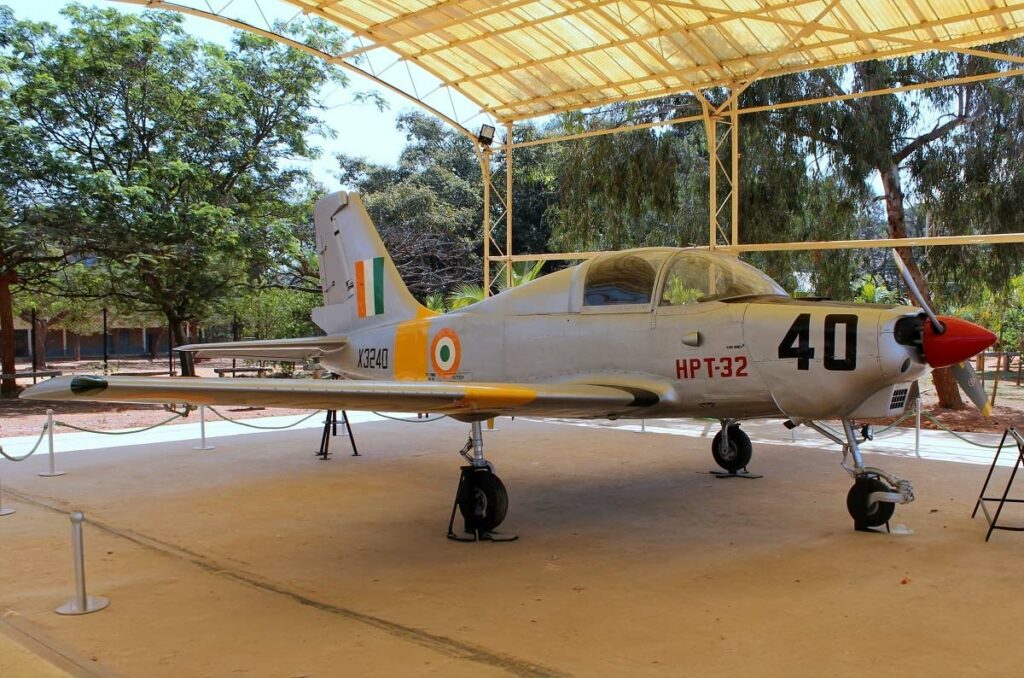Indian primary trainer aircraft, piston-engine, used for basic flight training.
In brief
The HAL HPT-32 Deepak is an Indian-built primary trainer aircraft designed and manufactured by Hindustan Aeronautics Limited (HAL). Introduced in the 1980s, it features a single piston engine, the Lycoming AEIO-540-D4B5, which produces 260 horsepower. The aircraft is designed with a low-wing configuration, fixed tricycle landing gear, and a tandem seating arrangement conducive to flight training. With a maximum speed of 143 knots and a range of 780 kilometers, the HPT-32 has been the backbone of basic flight training for the Indian Air Force (IAF) and the Indian Naval Air Arm. It is equipped for aerobatic maneuvers, instrument flight training, and has provisions for blind flying instruction.
History of the Development of the HAL HPT-32 Deepak
In the late 1970s, the Indian Air Force and Indian Navy identified a need for an indigenously developed primary trainer aircraft to replace their aging fleet of imported trainers. This was part of a broader push towards self-reliance in defense procurement, aligning with India’s strategic goal to build local industry capabilities. Hindustan Aeronautics Limited (HAL) was tasked with the development of this new trainer, which would be essential for basic flight training.
The development program for the HPT-32, named Deepak (meaning “lamp” or “light” in Hindi), was officially launched in 1977. The design aimed to create a robust, easy-to-maintain, and versatile training aircraft that could handle not only beginner training missions but also basic aerobatic and instrument flying, crucial for a comprehensive training regimen. The prototype of the HPT-32 first took to the skies on January 6, 1977, demonstrating promising performance and handling characteristics.
The aircraft does not have a NATO nickname, consistent with its role as a domestic trainer with limited export presence. The focus on the HPT-32 was to provide a reliable and effective training platform that could be operated and maintained with relative ease, utilizing resources available within the country.
Design of the HAL HPT-32 Deepak
The HAL HPT-32 Deepak was designed with several key objectives: ease of maintenance, robustness, and suitability for beginner pilots. The aircraft measures 7.85 meters in length and has a wingspan of 10.06 meters (25.8 feet long with a wingspan of 33 feet). The structure is predominantly of aluminum alloy, with some steel parts and fabric coverings over control surfaces.
Its engine, the Lycoming AEIO-540-D4B5, is a six-cylinder air-cooled design, producing 260 horsepower, driving a two-bladed, fixed-pitch propeller. This setup provides enough power for the aircraft’s needs while maintaining mechanical simplicity and reliability. The fixed tricycle landing gear enhances ground handling and is forgiving for new pilots.
One of the notable design features of the HPT-32 is its unobstructed tandem cockpit, which offers excellent visibility for both the instructor and the trainee, a critical factor in training environments. The cockpit is equipped with dual controls and basic flight instruments, with some aircraft later upgraded to include more modern avionics for IFR training.
However, despite its many advantages, the HPT-32 had significant drawbacks, particularly in safety. There were issues related to engine reliability and emergency egress, which proved critical in several accidents during its service life. These factors eventually led to the phase-out of the aircraft.

Performance of the HAL HPT-32 Deepak
In terms of performance, the HPT-32 can achieve a maximum speed of 143 knots (265 km/h) and has a service ceiling of 14,800 feet (4,511 meters). The aircraft’s range of 780 kilometers allows for extensive training sessions without the need for refueling, making it ideal for the varied requirements of flight training.
When compared to other primary trainers like the Beechcraft T-34 or the Cessna 152, the HPT-32 holds its own in terms of power and aerobatic capabilities but falls short in areas like avionics sophistication and fuel efficiency. Its simple design and robust construction were seen as beneficial for the rough handling expected in a training environment.
Variants of the HAL HPT-32 Deepak
The HAL HPT-32 was later developed into an upgraded variant known as the HPT-32B Deepak, which included improvements in avionics and minor aerodynamic refinements. Another notable variant is the proposed HTT-34, intended to be powered by a turboprop engine to enhance performance and safety, although this variant did not advance beyond the prototype stage.
Military Use and Combat of the HAL HPT-32 Deepak
The HPT-32 was primarily used by the Indian Air Force and the Indian Navy for basic flight training. Its role was to introduce new pilots to flying basics, instrument navigation, and initial aerobatic maneuvers. The aircraft was not designed for combat and does not carry any armaments.
Throughout its service, the HPT-32 was crucial in training several generations of Indian pilots. Despite its non-combat role, the aircraft’s importance to the Indian military’s training regimen cannot be overstated. However, due to safety concerns, particularly regarding engine failures and issues with emergency egress, the aircraft was gradually phased out and replaced by the HAL HJT-16 Kiran and later by more modern trainers like the Pilatus PC-7.
The HAL HPT-32 Deepak played a foundational role in the training of Indian military pilots, contributing significantly to India’s defense training capabilities. While its operational life was marred by safety challenges, its impact on pilot training in India during its service period was substantial, embodying the goals of self-reliance and indigenization in defense manufacturing.
Back to the Trainers section.